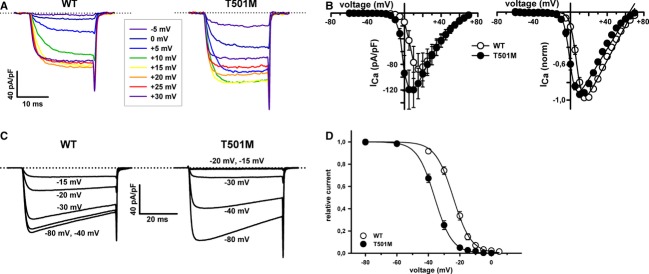Figure 4.

Mutation p.Thr501Met affects activation and inactivation properties of heterologously expressed P/Q channels. (A) Current traces illustrating voltage dependence of WT (left) and p.Thr501Met (right) P/Q channels, in response to 20 msec voltage pulses. Dotted lines in the current traces indicate the zero current level. (B) Current density–voltage relationships (left panels) and normalized I–V curves (right panels) for WT (○) and p.Thr501Met (•) P/Q channels expressed in HEK 293 cells. V1/2, act and kact values were (in mV): WT (○, n = 9) 7.1 ± 0.8 and 3.3 ± 0.3; p.Thr501Met (•, n = 14) −0.04 ± 0.99 and 2.8 ± 0.3, respectively. No significant difference was found for kact values (P = 0.29). (C and D) Steady-state inactivation of WT or p.Thr501Met P/Q channels. Amplitudes of currents elicited by test pulses to +20 mV were normalized to the current obtained after a 30-sec prepulse to −80 mV and fitted by a single Boltzmann function (see Materials and Methods, eq. 2). V1/2, inact and kinact values were (in mV): WT (○, n = 10) −24.2 ± 0.9 and −5.5 ± 0.4; p.Thr501Met (•, n = 15) −35.9 ± 1 and −5 ± 0.2, respectively. No significant difference was found for kinact values (P = 0.53).
